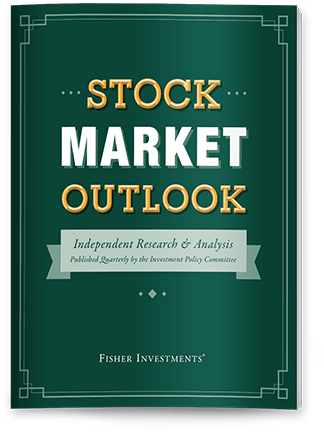Sources of Retirement Income
Once you retire, you may need to generate retirement income to support your lifestyle and potential future expenses. Some retirees assume their income options are limited to income-generating investments, but we believe this view is misguided.
There are many ways to use your retirement savings to generate income, and the strategy that’s right for you likely depends on your personal situation and investment approach.
Before you develop your retirement plan, you may want to familiarize yourself with some options for generating retirement income.
Income-Producing Stock and Bond Investments
Investors often believe investment income must come from income-generating assets (i.e., investments that pay income to the security holder). Here are some common assets investors may consider when planning for retirement income. Remember, though, these options may limit your investing flexibility.
High-Dividend Stocks as a Source of Income for Retirement
Generating retirement income from high-dividend-paying stocks may seem plausible. You can get equity exposure and receive ongoing dividend income. However, investing too heavily in these stocks can leave you overexposed to a small number of sectors.
Even if your returns are favorable, being overconcentrated within a limited area of the market could leave you vulnerable to trends and changes within that area. This overconcentration could even negate the portfolio diversification that is important to help reach your long-term investing goals.
Further, in market downturns, some companies reduce or stop paying dividends altogether. If you rely solely on dividends for your retirement income strategy, you could potentially find yourself short of cash if those companies or sectors go through tough times.
Relying on dividends as your primary source of income could also leave you vulnerable to inflation. As inflation rises, it erodes your purchasing power. Since 1925, inflation in the US has averaged approximately 3%1 Dividends don’t necessarily keep up with inflation, so your purchasing power could fall over time. If the dividend growth rate is less than inflation, your money will buy less and less.

Where Might the Market Go Next?
Confidently tackle the market’s ups and downs with independent research and analysis that tells you where we think stocks are headed—and why.
Bonds as a Source of Income for Retirement
Many bonds provide consistent, relatively predictable interest payments called coupons. This fact may make bonds a viable investment option if you have a shorter investment time horizon or require lower short-term market volatility than stocks. However, bonds may not be the best fit if you require longer-term portfolio growth.
Bonds have historically produced lower returns than stocks over the long-term (think 20 – 30 years). Whether bonds are right for you depends largely on your long-term goals and financial situation.
Also, keep in mind that bonds come with their own set of risks. Here are a few examples of potential bond risks:
Default risk. This is the risk the issuer fails to pay you interest or repay your principal. Issuers with lower credit ratings may offer higher interest payments to attract investors but often have higher default risk.
Interest rate risk. Bond prices and interest rates have an inverse relationship. A rise in interest rates generally cause a bond’s values to fall. If you need to sell your bonds before maturity, you could incur a capital loss if interest rates have risen since your initial purchase.
Reinvestment risk. After your bonds mature and your principal is returned, you may be unable to find replacement bonds offering a comparable yield. If interest rates have dropped, you may have to accept a lower coupon rate for a similar amount of risk.
Inflation risk. Rising inflation may erode the purchasing power of your fixed income payments over time. Furthermore, interest rates tend to reflect investors’ inflation expectations. If inflation is rising, it can cause your bond values to fall while reducing the purchasing power of your interest income. This “double whammy” may be especially painful if you rely primarily on bonds for retirement income.
Other Potential Sources of Retirement Income
Some investors look beyond stocks and bonds for other potential sources of retirement income.
Annuities
Annuities are a type of insurance product that guarantee the holder a fixed or variable payment at some future time. Many retirees are attracted to the income features of annuities. Some annuities may even offer lifetime income. However, you should consider annuities’ potential limitations before purchasing one.
Here are a couple important questions to ask when considering annuities:
- Are the costs worth it? Annuities often come with additional benefits, called “riders,” such as income protection from inflation. However, these riders come with additional fees. Ongoing fees combined with additional rider fees can significantly reduce your long-term returns.
- What are the costs of illiquidity? Once you purchase an annuity, it may be difficult to access your money if you need it sooner—or want to change your strategy. Withdrawing funds from your annuity contract earlier than planned may result in additional surrender fees.
Real Estate
Some investors look to generate income from real estate investments, usually broken down into two categories: direct and indirect.
- Direct real estate investment typically refers to owning residential or commercial buildings to develop the property, resell or just collect rental income. If you are thinking of investing directly in real estate, be aware of potential costly property upkeep. And if tenants are unable to pay rent, you will be responsible for property debt obligations while you attempt to resolve issues and collect payments.
- Indirect real estate investment typically involves buying shares in a publicly or privately held investment vehicle. Real estate investment trusts (REITs) are the most common indirect real estate investment. Understand, though, that some REITs may lack liquidity. Also note that you may not have control over which properties the REIT selects as underlying investments.
Potential Non-Investment Income Sources
When retirement planning, you may consider additional income sources to help fund your lifestyle.
- Salary. If you want to work while retired, you will need to estimate how much you can expect to receive on a regular basis.
- Pension. If your employer offers a pension, you should determine what your monthly benefit could be.
- Social Security. If you have started taking Social Security retirement benefits, you may be familiar with how much you receive. If you haven’t yet, you may want to determine the age at which you wish to start receiving Social Security benefits and how much you can expect to receive each month. While you can start receiving Social Security retirement benefits as early as age 62, your full benefits are reduced a certain percent for each month before your “full retirement age.” For more detailed information, you can visit the Social Security Administration benefits page.
- Business. Running a business during retirement can provide non-investment income. This income may be more susceptible to economic conditions than Social Security or a guaranteed pension.
An Alternative Solution to Your Retirement Income Needs
If you require longer-term growth and income during retirement, a personalized investment portfolio capable of achieving growth while providing the necessary cash flow might be an appropriate solution. We refer to this as “generating homegrown dividends,” and it involves selective, incremental selling of securities for cash flow. While investors can incur trading commissions through this strategy, it is a flexible and potentially tax-efficient way to generate cash flow in a taxable account, especially for investors with larger portfolios.
We believe investors should weigh the pros and cons of relying on any single source of investment income for the long term. Whether in retirement or approaching retirement, some investors may be better off creating their own cash flow via homegrown dividends instead of relying solely on interest or dividends.
Fisher Investments Can Help
A second set of eyes on your financial future and income needs is a good idea. Contact Fisher Investments to speak with one of our experienced professionals. You can also download one of our educational guides to determine which sources of retirement income can help you meet your retirement goals and objectives.
1 Finaeon, Inc., as of 7/28/2025. United States Consumer Price Index from 12/31/1925 – 6/30/2025, average annualized inflation was 2.95%.
